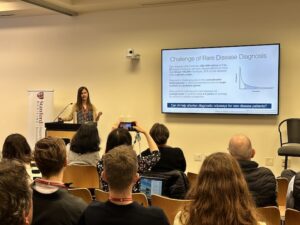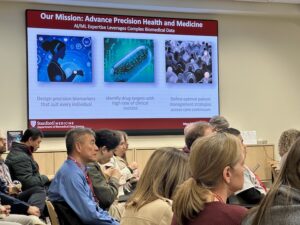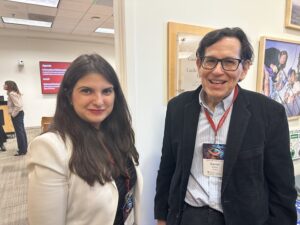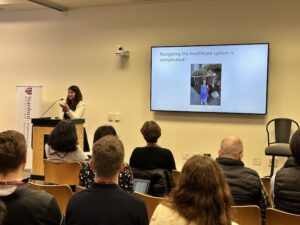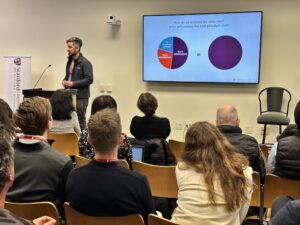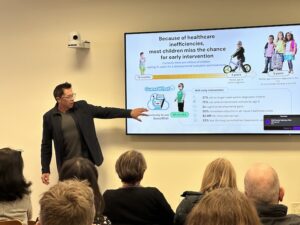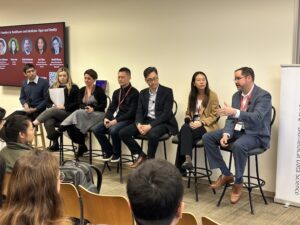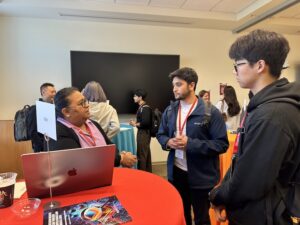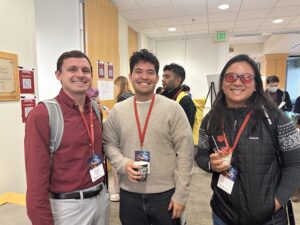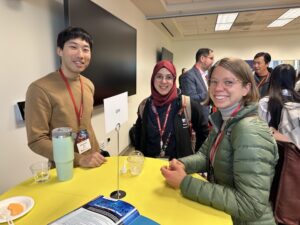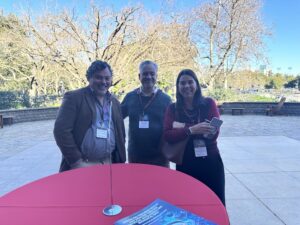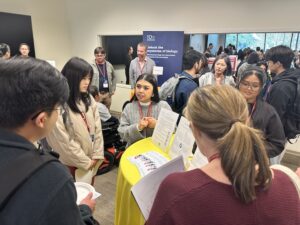Collaboration & Careers Forum 2025 Overview
“This is a new era for us,” Chair of the Department of Biomedical Data Science Sylvia Plevritis began, opening the third annual Collaboration & Careers Forum on January 16, 2025. The event, which connected leaders from various sectors with DBDS faculty, students, and researchers to discuss technological advancements in precision healthcare, focused heavily on new developments in AI. It explored how those advancements could be applied to improve efficiencies and health outcomes.
“AI can give us so many potential new ways to monitor our health,” Plevritis continued. “I deeply believe that precision health and medicine are very much molecular and that the integration of these molecular readouts — together with understanding of clinical events — is going to be the transformative aspect of the knowledge revolution.”
Along with advancements in AI, the Forum covered other computational technology developments and the responsibility surrounding the use of AI. The Forum was developed by Karen Matthys, DBDS Executive Director, and was led by Karen along with faculty members Roxana Daneshjou and Daniel Rubin. “The vision is to build an ecosystem between industry, government, nonprofits and DBDS researchers and catalyze cross-sector collaboration, Matthys said. “This is critical to achieve the breakthroughs we all want to see in healthcare.” Organized by DBDS staff and several graduate students, the event was the best attended in its three-year history. More than 160 students, post-docs, faculty, researchers and external partners came together to listen to faculty lightning talks, participate in the interactive collaboration forum, and engage with a panel of healthcare care and life sciences industry experts discussing the increasing role AI is playing in each of their organizations.
“AI is an increasingly hot area of work in biomedicine,” Rubin said. “Many headlines in the media and press tout the promise, but already there are some new challenges. The Forum provides an opportunity to provide a balanced perspective on the present and future of AI in biomedicine, including both the excitement with the reality.”
The faculty lightning talks showcased the recent research in the labs of six DBDS professors (see abstracts here):
- Emily Alsentzer
- Carlos Bustamante
- Roxana Daneshjou
- Stephen B. Montgomery
- Mirabella Rusu (represented by Cynthia Xinran Li, member of Rusu Lab)
- Dennis Wall
The topics ranged from knowledge-enhanced foundation models for healthcare, using multi-omics to study undiagnosed rare diseases, to the creation of an adaptive digital game for healthy child development.
“One of the goals of our research is how we can better infuse biomedical domain knowledge with machine learning models to produce models that are more generalizable, trustworthy and clinically useful,” Alsentzer said, discussing her research.
Prof. Dennis Wall, who presented his work on an adaptive digital therapeutic game that his lab has been building, explained his group has worked for quite a long time trying to identify better ways to diagnose and support children with developmental delays including autism. “The game has an action data feedback loop where you are continuously growing this data set over time to give you more details on the solution,” he added.
During her presentation, “Generative AI for Healthcare,” Roxana Daneshjou explored how generative AI could improve the physician and patient experience. She used an example when her daughter sustained a broken arm and the after-visit summary erroneously suggested an unusually large dosage amount of Tylenol, possibly causing the 40-pound child to experience immediate liver failure. Daneshjou entered the full hospital discharge summary into ChatGPT, which informed her the dosage was indeed dangerous. To Daneshjou, it was a lightbulb moment. “This is the promise, this is where we are going, a large language model AI assistant,” she said. “I don’t think we’re fully there yet, but I see this department as a place that can do things like that. That’s what’s so unique about our department; we sit at the nexus of everything.”
During the networking session, in which more than 30 industry leaders conversed with faculty and students, the room was buzzing with the exchange of ideas about opportunities to identify and foster collaborations. For example, Accenture, a global professional services company, recently partnered with DBDS to explore the possibilities of AI-assisted cancer tumor boards, the work of which ultimately resulted in an $8.9 award from ARPA-H to further the research.
“It is our hope that Microsoft can provide the Collaboration & Careers Forum with real-world insights regarding the pressing needs and business opportunities for AI in healthcare, and that the Collaboration and Careers Forum can provide the healthcare industry with individuals trained to address those needs,” said David Rhew, Global Chief Medical Officer & Vice President of Healthcare at Microsoft.
Rhew also participated in the panel discussion, “AI Frontiers in Healthcare and Medicine: Hype and Reality” composed of industry leaders and experts and moderated by students Rebecca Hurwitz and Rohit Khurana. The informative session explored how companies were using AI currently in their work and what is expected to develop soon.
Panelists included:
- Laetitia Cailleteau, Managing Director, Responsible AI & Generative AI Studios Europe, Accenture
- Vivien Ho, Partner at Pear VC
- Matt McGinnis, VP of Data & Analytics at Evernorth
- David Rhew, Global Chief Medical Officer & VP of Healthcare, Microsoft
- Jun Qian, Vice President of Generative AI Services at Oracle
The industry leaders led a lively conversation covering issues about using large data sets and screenings to identify potential health risks, developing a better care delivery system, leveraging synthetic data, improving precision in predictions for healthcare, and developing new AI toolkits.
Matt McGinnis of Evernorth spoke about his vision for AI enabling more precise predictions and better recommendations, especially for populations and patients at risk. “The more precise, the more personalized we can be and understand what’s important to all the stakeholders, the better the outcomes.”
Vivien Ho from Pear VC spoke about 2025 as the year of the hard ROI for AI in healthcare – going beyond pilots to show that the solutions either save costs or improve outcomes. She was particularly excited about one new app where you can ask a medical question and get a response from a doctor, empowered by AI. “It’s like having a doctor in your family,” Ho said, “and it’s working with payers already.”
Cailleteau, who was a member of the working group that established the basis of the European Union’s AI Act — the world’s first comprehensive AI law — addressed the issue of how ethics and fairness in AI are deployed in healthcare settings. “The intention of the EU AI is to protect human rights and associated safety. Those are the two key principles that help define all the regulation elements,” she said. “The EU AI is risk-based, so if your AI system can cause a risk to human rights or physical safety then you’re going to be high risk, and therefore you will have several requirements and obligations that are going to mandate quality in your system development. In North America, for example, Colorado has a mini version of the EU AI act, and there’s several regulations coming up in California, specifically.
“I currently have more than 80 clients in Europe that are going through that process, and I can tell you this is a blessing because this is the first time people put a lot of investment in rethinking how they’re going to govern AI in industry, but it’s quite disappointing to see where the industry is now. A lot of companies have put an ethical charter on their website, but haven’t really operationalized how they deal with AI or even a simple question, like do you know where your inventory is or in any other system? There’s still a gap in between the policies and the solutions that are available in the market.”
For Alsentzer, who joined DBDS this past September and participated in the Collaboration and Careers Form for the first time, the event was a fantastic way to connect academia and industry. “(The Forum) helps to build meaningful, long-term partnerships and gives students a clearer picture of industry opportunities. As a new faculty member, I appreciated the chance to meet potential collaborators in the Bay Area and explore ideas for advancing precision healthcare,” she said.
Students and postdocs attending the Forum don’t only learn what is upcoming in industry developments or the most exciting aspects of AI from global leaders; the networking session brings opportunities to meet the leaders in the field and potentially connect with businesses that are looking for interns or those soon seeking employment.
“The networking session was the most important and best aspect of the Forum,” said Perla Molina, a second-year Ph.D. candidate. “It’s worth the time to connect and inquire about industry as it really helps solidify options for post-grad. It also is extremely valuable knowing not only what kind of biomedical data science research happens in industry, but how it differs from academia. . .is there a publication expectation, what are the deadlines like, how does collaboration work between teams and/or other companies, work-life balance, etc. I also personally loved the presence of academic opportunities there, like the Emerson Scholars Program, as it was something I was never aware of that existed at Stanford.”
McGinnis agrees that events and collaborations like the Forum are the way to join industry with groundbreaking research conducted in departments like DBDS, and together, reach the potential that AI has to offer in precision healthcare.
“While we operate and contribute to different parts of the healthcare system, we are working on very similar objectives – how can data science and AI help people live healthier lives?” he said. “The opportunity to meet and interact with faculty and the department is valuable. Building relationships and learning about the research of DBDS is very informative. Research in areas like behavioral, women’s health, autism and rare conditions align to Evernorth’s priorities and are great examples of areas we can partner together on.”
Video clips from Collaboration and Careers Forum, 2025:
—DBDS Communications

